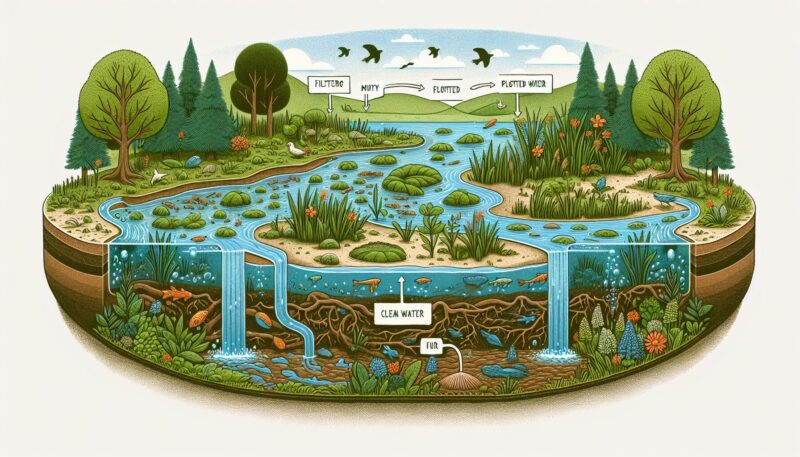Wetlands are some of the most productive and biologically diverse ecosystems on the planet. They provide a unique set of functions that benefit the environment and human society alike. From acting as natural water filters to supporting a vast array of wildlife, the importance of wetlands cannot be overstated. However, despite their value, they are among the most threatened habitats in the world.
What are Wetlands?
Wetlands are transitional areas between terrestrial and aquatic systems where the water table is usually at or near the surface, or the land is covered by shallow water. They are characterized by a prevalence of hydric soils, which are saturated enough to support a wetland ecology of plants and animals not found in dry environments. Examples of wetlands include marshes, swamps, bogs, fens, and estuaries.
Natural Water Filters
One of the key functions of wetlands is their ability to improve water quality. They act as natural filters, trapping sediments, and removing pollutants from the water that flows through them. This filtration process involves a variety of physical, chemical, and biological mechanisms.
Sediment Trapping
As water moves slowly through a wetland, sediment and associated pollutants settle out. This is because the still waters of a wetland are not fast enough to keep particles suspended. By trapping these sediments, wetlands help to prevent erosion and the siltation of other ecosystems such as rivers and lakes.
Nutrient Removal
Wetlands are often referred to as ‘nutrient sinks’. They have the ability to absorb and store nutrients such as nitrogen and phosphorus, which are common pollutants from agricultural runoff and sewage discharges. Some wetland plants can absorb and store these nutrients in their tissues, which are later removed when the plant is harvested or dies and decays in an area where it does not impact water quality.
Chemical Transformation
Wetlands can also transform pollutants through a variety of chemical processes. For example, the microorganisms in wetland soils can convert nitrates in the water to nitrogen gas, which is then released harmlessly into the atmosphere – a process known as denitrification.
Pathogen Removal
Pathogens can be removed from the water in wetlands through filtering processes, natural die-off, and predation by other organisms. Wetland vegetation with their dense roots and slow-moving waters provide an ideal environment for these processes to occur.
Biodiversity Hotspots
Wetlands are some of the most diverse ecosystems on earth. They provide habitat for a vast array of species including fish, birds, amphibians, and insects. Many species are directly dependent on wetlands for their survival, such as the many species of waterfowl that use them as nesting and breeding grounds.
Migratory Bird Habitat
Many migratory bird species depend on wetlands as resting points during their long journeys. Wetlands provide food, shelter, and breeding sites necessary for these species to survive and reproduce.
Fish Nurseries
Numerous fish species use wetlands as nurseries for their young. These shallow waters provide a safe haven from predators and a rich food supply, which is critical for the survival of fish larvae and juveniles.
Ecosystem Services and Human Benefits
Wetlands provide a wealth of ecosystem services that benefit humanity. These include water purification, flood protection, shoreline stabilization, and climate change mitigation.
Water Purification
As natural water filters, wetlands play a critical role in ensuring clean water for human consumption and use. By removing pollutants from runoff before it reaches our waterways, wetlands contribute to the maintenance of water quality.
Flood Protection
By absorbing excess rainwater, wetlands can reduce the severity of floods. This sponge-like characteristic means that wetlands can help protect communities from the potentially devastating effects of flooding.
Shoreline Stabilization
Coastal wetlands, such as mangroves and salt marshes, help to stabilize shorelines and reduce erosion by dissipating wave energy and binding the soil together with their root systems.
Climate Change Mitigation
Wetlands also play a role in mitigating climate change. They are significant carbon sinks, sequestering carbon dioxide from the atmosphere and storing it in their plant biomass and soils.
Conservation and Restoration
Recognizing the many values of wetlands, conservation and restoration efforts are becoming increasingly important.
Wetland Protection Legislation
Many countries have developed legislation to protect wetlands. In the United States, the Clean Water Act and the ‘No Net Loss’ policy are key components of wetland conservation. These policies aim to prevent the destruction of wetlands and require that any losses are compensated by the creation or restoration of wetland areas elsewhere.
Restoration Projects
In areas where wetlands have been degraded or destroyed, restoration initiatives are working to bring back these vital ecosystems. Restoration can involve the re-plantation of native vegetation, the reintroduction of natural water flow patterns, and the monitoring and management of invasive species.
Challenges
Despite their crucial role, wetlands are facing many challenges, including pollution, invasive species, and the pressures of land development.
Pollution
Nutrient runoff, heavy metals, and other contaminants can overwhelm the filtration capacity of wetlands, leading to degraded water quality and loss of wildlife habitat.
Invasive Species
Invasive plants and animals can disrupt the delicate balance of wetland ecosystems, often outcompeting native species and altering habitat conditions.
Land Development
The conversion of wetlands to agricultural or urban use has historically been the largest cause of wetland loss. Although policies are in place in many regions to reduce this impact, development pressures continue to threaten wetlands around the world.
Conclusion
Wetlands are invaluable ecosystems that contribute significantly to the health of the planet and the well-being of people. They act as nature’s own water filters, provide habitat for a multitude of species, and deliver a range of ecosystem services. The conservation and restoration of wetlands is a critical component of sustainable environmental management. It’s essential that we continue to protect these areas for the benefits they provide and for future generations to enjoy.
Sources
- United States Environmental Protection Agency (EPA). (n.d.). Wetlands Overview. https://www.epa.gov/wetlands
- Ramsar Convention on Wetlands. (n.d.). The List of Wetlands of International Importance. https://www.ramsar.org/
